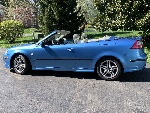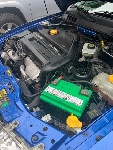
1979-1993 & 94 Conv [Subscribe to Daily Digest] |
| [Main C900 Bulletin Board | BBFAQ |
Prev by Date | Next by Date | Post Followup ]
Member Login / Signup - Members see fewer ads. - Latest Member Gallery Photos
CONSOLIDATED NOTES ON SETTING CO MIXTURE FOR BOSCH LH2.2  8 Saabers Like This Post! 8 Saabers Like This Post!
Posted by Notnoel [Email] |
As a few of you may know, I recently rebuilt my 1988 engine and had CMyles rebuild a transmission for me; I also rebuilt a set of axles with new Lobro CV joints. I went totally OCD and replaced virtually every peripheral (water pump, timing chains, alternator, steering pump and rack, and of course fuel injection components/sensors. My goal is to have a powerplant that is as close to factory new as I can get to, plus performance perks including equal length headers, a new 16g Mitsy turbo, and type 8 primaries.
I have finished and this week end have been fine tuning from the ground up. As part of this process, I needed to refresh my memory on setting up the CO for LH2.2. So, in keeping with the OCD theme, I just spent 2 hours reviewing postings and cutting and pasting the best of them into a WORD document to print out. But why stop there? So I edited that into a FAQ I plan to send to Scott.
Would folks knowledgeable of LH2.2 please read this and give me you thoughts/revisions. Many thanks to those who posted (and whose words I stole): Anders, Jeff Cullen, Ari, and a handful of others.
CONSOLIDATED NOTES ON SETTING CO MIXTURE FOR BOSCH LH2.2
The AMM controls 100% of the fuel flow; the O2 sensor about 25%. The O2 sensor works in a very narrow range. You 'coarse adjust' the AMM to get the mixture near right, and then the O2 sensor takes over. If the AMM is set too rich or too lean, the O2 sensor doesn't have a chance to work. The adjusting screw changes the resistance by 40 ohms/ half-turn, clockwise increases resistance (richer), counterclockwise decreases resistance (leaner).
There are two ways - one is to put a voltmeter right on the output of the O2 sensor (while it's still connected!) and adjust the AMM as discussed by Bentley and Ari (below). The other method, discussed extensively by Anders and which appears to be more straight forward, is to measure at the LH Test Connector. I believe using this method is more accurate than testing through the O2 sensor. Stated most simply, dig out that 3-prong test connector above the passenger side wheel well, it has a red/grey stripe (ground), a green (fuel mixture), and a purple/white (check engine light). So connect the test meter (voltage) leads as green= positive, red/grey as negative. Adjust the AMM until the voltage sweeps evenly back and forth between 0 and 12 volts. There are some nuances as discussed below in more detail.
The test connector is just an amplified and squared-up version of the O2 signal. Basically, you want to adjust the AMM until the signal on the test connector starts to bounce between 0 and 12 volts. Ideally, it would spend 50% of the time at 0, and 50% at 12V. Without knowing the sample and update rate of the digital meter you have, the best you can do is get the voltage to jump around - it shows that you've got the O2 sensor working. An analog meter is easier to visualize than a digital meter.
If it's closer to 1V most or all of the time, the engine is running too lean and the resistance on the AMM needs to be increased. If it's closer to 10V most or all of the time, the engine is running too rich and the resistance on the AMM needs to be reduced. I find different cars like different resistance values in order to be happy and be in this nicely fluctuating range.
The purpose of the adjustment is to use the AMM to compensate for a lot of other variables in the fuel injection system - small leaks, AMM to AMM variation, fuel injectors, the works. The AMM adjusts fuel flow based on air. The O2 sensor measure mixture - lean or rich. You want to adjust the AMM so that at idle, the mixture is right between lean and rich. The AMM adjusting screw is turned clockwise for richer, counter-clockwise for leaner.
Starting from Scratch
Remove the plug from the potentiometer screw on the side of the mass air flow sensor.
Unplug the wiring harness connector from the mass air flow sensor. Connect the multimeter to pins 3 and 6 as shown in the figure. Adjust the screw until the resistance reads 380 ohms.
Adjust as necessary by turning the potentiometer screw. This is the first step in checking and adjusting the basic setting. The magical 380 ohms on the AMM is only the starting point. That setting on the AMM will permit most cars to run. As said, that 380 is only a starting point - I've seen cars tuned perfectly with resistances well over 700 ohms (on a very old AMM).
Get in Range
If the AMM calibration (initial setting at 380 ohms) is too far out of range for the given engine/ECU, the voltmeter will not read properly. If the AMM is out of calibration range, you should see either 0 or 12V. The AMM setting of 380 ohms (across pins 3 & 6) is just a starting point, the adjusting screw changes the resistance by 40 ohms/ half-turn, clockwise increases resistance (richer), counterclockwise decreases resistance (leaner). On a good Bosch original, the meter should start to cycle between 0 and 12 V somewhere in the range of 150-600 ohms (+/- 5 turns on the adjustment screw). But, on some rebuilt units, it is not unusual to go a number of turns clockwise get it to start cycling, and the final resistance was high.
If adjustment is necessary, turn the potentiometer screw in the mass air flow sensor as follows:
If the needle remains stationary at the higher end of the scale or spends most of its time at this end, turn the screw anticlockwise until the needle stays roughly the same length of time at both ends of the scale. If the needle remains stationary on the lefthand side of the scale, turn the potentiometer screw until it stays roughly the same length of time at both ends of the scale.
Method 1: the “Anders Method”
Read pins 3 and 6 and record the resistance. That way, if you really mess it up, you can always re-adjust it back with a meter. Plug the wiring harness into the mass air flow sensor again. Start the engine and run it until the radiator fan cuts in. Connect an analog voltmeter the test point adjacent to the evaporator housing. It's a three-prong plug, and on the side of that, a 1-prong plug. The one prong plug (green with red stripe) is to ground out the AIC motor when setting the base idle. On the 86-88 16V (89 the adjustable AMM disappeared) you can find it hiding under the square power block (where the red cable from battery comes in). On the 85 16V models it's hiding right by the P/S reservoir.
This test socket is near the OEM O2 sensor wire socket (by passenger fender hanging free and unattached next to the power accessory block. It has 3 wires running into it and 3 blade type female plugs in a T-shaped plastic housing. That three prong female connector is wired thus; The gray and red wire, which is the odd prong, the one that lays 90 degrees to the other two, is just 12 volts from the fuel pump relay, the violet and white wire is the "limp home test point" and is connected to pin 19 of the ECU (which also goes to the "check engine" light), the green wire goes to pin 22 of the ECU and is the "base line calibration" lead. That's the one you are interested in. If you are looking at the end of the connector, looking down into the blade holes with the odd one on top, it's the one on the left.
Using an analog meter with a setting for a range of 0-12v or just over, connect the test meter (voltage) leads as green= positive, red/grey as negative and adjust the AMM screw until you get an evenly paced swing on the meter's needle between 0v and 12v. If your analog voltage meter jumps backwards under zero, just switch polarity.
One caution though with using that test socket, if the O2 sensor is not working properly, it will not send the pulsing signal to ECU and subsequently, the ECU will not send a pulsing signal to the test socket.
If you get steady 0V, the fuel mixture is too lean. If you get a steady 12V, it's too rich. When the Voltage is going all over the spectrum in an even speed, the fuel mixture is right. It's a very quick test to confirm that the ECU, AMM and O2 sensor are working properly.
The voltage showing on the meter is more of an end of the line reading in the sense that it is the representation of what the ECU is telling the injectors to do based on the info it receives from any component that sends it info. This also represents the correct small fluctuation between rich and lean that LH 2.2 exhibits at warm idle when tuned correctly and shows up as the small 50 or so variation in RPM.
If the basic setting is correct, the meter needle will swing back and forth between both ends of the scale. Note: The movement of the needle will not be rapid and there may be a pause between each movement. Dial in the AMM until the signal is swinging properly between the two ends of the scale, spending roughly equal amounts of time at each end over a minute or so of fully-warmed-up idle. If I can't get the AMM adjusted properly, I replace the O2 sensor.
Notes on Anders Method
When perfect, the voltage will swing between 0 and battery voltage at test plug during steady load acceleration (not full throttle though) but any movement of throttle will alter the swing until steady load is achieved again.
What the Saab Master tech's where CMyles used to work found out was that you can adjust the CO screw all day long on a defective AMM and it will never be right (because it's busted). The adjustment can be performed successfully on a good AMM of course but rarely needs to be. So have a spare, known good, AMM on hand.
Bentley is incorrect, BTW, when it tells you to disconnect the O2 sensor for AMM adjustment.
If you adjust the fuel mixture at that socket to where the volt meter fluctuates evenly between 0 and 12 V, and then disconnect the O2 sensor and measure the voltage coming out of the O2 sensor signal wire. You will discover that the signal voltage is at a steady low voltage (around 0.1V).
Only when you hook the signal wire back up to the ECU harness will it start to fluctuate between 0.1V to 0.9V. That's the setting/mapping of the ECU.
The Ohm reading on AMM will never tell you if the AMM is bad or not. It is other things inside the AMM that goes bad and is not traceable with an Ohm or Voltmeter.
Method 2: Measuring Output at the O2 Sensor via Bentley/Ari
You can easily adjust for close loop by connecting digital (high impedance) voltmeter to O2 sensor (leave sensor lead connected, just tap in with probe). Use a digital meter – posts suggest that a high impedance meter is better for this purpose and safer for the engine. Then adjust AMM to give equal swings in O2 voltage on either side of 0.5VYou need to measure the output of the O2 sensor. The output of the O2 sensor should vary between about 0.2 and 0.9 volts. This signal goes to the ECU. Voltage should fluctuate and spend about equal time above and below .5 volt.
What you need to do is get the signal wire from the O2 sensor. Typically there are three wires, two of one color, one of another. The two of one color are the heater - ignore that. Look for the wire of another color- that's the signal wire. (Yes, later cars have four wire O2 sensors, but they also don't have adjustable AMMs).
You need to measure the voltage on that wire without disconnecting it from the system. If you can get to the connector, stick the positive lead of the meter into the connector pin. If you can't get to the connector, what I do is stick a pin in the wire, through the insulation, and connect the positive lead of the meter to the pin. Connect the negative lead of the meter to a good ground, like the engine.
Set the meter to volts. Ideally, you want a good old analog voltmeter with a needle. You can also use a digital meter. Start the car, let it warm up, and make sure the idle is right. It should be around 850 rpm. You don't want a 1000 rpm idle. Watch the meter. If it is an analog voltmeter, you want to see the needle swing back and forth between 0.2 and 0.9 volts, averaging around 0.5 If it's a digital voltmeter, it's harder - you want to see numbers above and below 0.5. If the voltage is stuck up around 0.9, the engine is running rich. If it's stuck down at 0.2, it's running too lean.
You want to adjust the screw first so that the meter is changing - not stuck on 0.2 or 0.9. That's usually good enough. If you want to get really fine, try to adjust the screw so that the average is about 0.5 volts, spending 50% of the time above 0.5, and 50% of the time below 0.5 volts. That's harder without the right meter.
If your engine is already running OK, do yourself a favor and measure the resistance. That way, if you really mess it up, you can always re-adjust it back with a meter. If you don't want to do that, count how many turns you go one way or another as you adjust, so that you can at least go back to where you started. Yes, there is a test point to check the O2 sensor voltage, but it varies from year to year and I've never been good at finding it. So I just stick a pin in the wire. I cover it with some electrical tape afterwards.
 8
8 , Thu, 15 Jun 2017 18:40:36
, Thu, 15 Jun 2017 18:40:36
No Site Registration is Required to Post - Site Membership is optional (Member Features List), but helps to keep the site online
for all Saabers. If the site helps you, please consider helping the site by becoming a member.
 |
 |
 |
 |
 |



